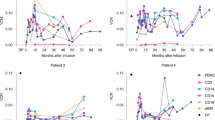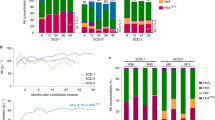Abstract
The β-haemoglobinopathies are the most prevalent inherited disorders worldwide. Gene therapy of β-thalassaemia is particularly challenging given the requirement for massive haemoglobin production in a lineage-specific manner and the lack of selective advantage for corrected haematopoietic stem cells. Compound βE/β0-thalassaemia is the most common form of severe thalassaemia in southeast Asian countries and their diasporas1,2. The βE-globin allele bears a point mutation that causes alternative splicing. The abnormally spliced form is non-coding, whereas the correctly spliced messenger RNA expresses a mutated βE-globin with partial instability1,2. When this is compounded with a non-functional β0 allele, a profound decrease in β-globin synthesis results, and approximately half of βE/β0-thalassaemia patients are transfusion-dependent1,2. The only available curative therapy is allogeneic haematopoietic stem cell transplantation, although most patients do not have a human-leukocyte-antigen-matched, geno-identical donor, and those who do still risk rejection or graft-versus-host disease. Here we show that, 33 months after lentiviral β-globin gene transfer, an adult patient with severe βE/β0-thalassaemia dependent on monthly transfusions since early childhood has become transfusion independent for the past 21 months. Blood haemoglobin is maintained between 9 and 10 g dl−1, of which one-third contains vector-encoded β-globin. Most of the therapeutic benefit results from a dominant, myeloid-biased cell clone, in which the integrated vector causes transcriptional activation of HMGA2 in erythroid cells with further increased expression of a truncated HMGA2 mRNA insensitive to degradation by let-7 microRNAs. The clonal dominance that accompanies therapeutic efficacy may be coincidental and stochastic or result from a hitherto benign cell expansion caused by dysregulation of the HMGA2 gene in stem/progenitor cells.
This is a preview of subscription content, access via your institution
Access options
Subscribe to this journal
Receive 51 print issues and online access
$199.00 per year
only $3.90 per issue
Buy this article
- Purchase on Springer Link
- Instant access to full article PDF
Prices may be subject to local taxes which are calculated during checkout




Similar content being viewed by others
References
Fucharoen, S. & Winichagoon, P. Clinical and hematologic aspects of hemoglobin E β-thalassemia. Curr. Opin. Hematol. 7, 106–112 (2000)
Olivieri, N. F. et al. Studies in haemoglobin E β-thalassaemia. Br. J. Haematol. 141, 388–397 (2008)
Grosveld, F., van Assendelft, G. B., Greaves, D. R. & Kollias, G. Position-independent, high-level expression of the human β-globin gene in transgenic mice. Cell 51, 975–985 (1987)
Tuan, D. & London, I. M. Mapping of DNase I-hypersensitive sites in the upstream DNA of human embryonic ε-globin gene in K562 leukemia cells. Proc. Natl Acad. Sci. USA 81, 2718–2722 (1984)
May, C. et al. Therapeutic haemoglobin synthesis in β-thalassaemic mice expressing lentivirus-encoded human β-globin. Nature 406, 82–86 (2000)
Pawliuk, R. et al. Correction of sickle cell disease in transgenic mouse models by gene therapy. Science 294, 2368–2371 (2001)
Hanawa, H. et al. Extended β-globin locus control region elements promote consistent therapeutic expression of a γ-globin lentiviral vector in murine β-thalassemia. Blood 104, 2281–2290 (2004)
Imren, S. et al. Permanent and panerythroid correction of murine β thalassemia by multiple lentiviral integration in hematopoietic stem cells. Proc. Natl Acad. Sci. USA 99, 14380–14385 (2002)
Levasseur, D. N., Ryan, T. M., Pawlik, K. M. & Townes, T. M. Correction of a mouse model of sickle cell disease: lentiviral/antisickling β-globin gene transduction of unmobilized, purified hematopoietic stem cells. Blood 102, 4312–4319 (2003)
Malik, P., Arumugam, P. I., Yee, J. K. & Puthenveetil, G. Successful correction of the human Cooley’s anemia β-thalassemia major phenotype using a lentiviral vector flanked by the chicken hypersensitive site 4 chromatin insulator. Ann. NY Acad. Sci. 1054, 238–249 (2005)
Chung, J. H., Whiteley, M. & Felsenfeld, G. A 5′ element of the chicken β-globin domain serves as an insulator in human erythroid cells and protects against position effect in Drosophila. Cell 74, 505–514 (1993)
Miccio, A. et al. In vivo selection of genetically modified erythroblastic progenitors leads to long-term correction of β-thalassemia. Proc. Natl Acad. Sci. USA 105, 10547–10552 (2008)
Cleynen, I. & Van de Ven, W. J. The HMGA proteins: a myriad of functions. Int. J. Oncol. 32, 289–305 (2008)
Lee, Y., Jeon, K., Lee, J. T., Kim, S. & Kim, V. N. MicroRNA maturation: stepwise processing and subcellular localization. EMBO J. 21, 4663–4670 (2002)
Sadelain, M. Recent advances in globin gene transfer for the treatment of β-thalassemia and sickle cell anemia. Curr. Opin. Hematol. 13, 142–148 (2006)
Hargrove, P. W. et al. Globin lentiviral vector insertions can perturb the expression of endogenous genes in β-thalassemic hematopoietic cells. Mol. Ther. 16, 525–533 (2008)
Arumugam, P. I. et al. Genotoxic potential of lineage-specific lentivirus vectors carrying the β-globin locus control region. Mol. Ther. 17, 1929–1937 (2009)
Hanawa, H., Yamamoto, M., Zhao, H., Shimada, T. & Persons, D. A. Optimized lentiviral vector design improves titer and transgene expression of vectors containing the chicken β-globin locus HS4 insulator element. Mol. Ther. 17, 667–674 (2009)
Sieburg, H. B. et al. The hematopoietic stem compartment consists of a limited number of discrete stem cell subsets. Blood 107, 2311–2316 (2006)
Dykstra, B. et al. Long-term propagation of distinct hematopoietic differentiation programs in vivo. Cell Stem Cell 1, 218–229 (2007)
Abkowitz, J. L., Catlin, S. N. & Guttorp, P. Evidence that hematopoiesis may be a stochastic process in vivo. Nature Med. 2, 190–197 (1996)
Bottardi, S. et al. Lineage-specific transcription factors in multipotent hematopoietic progenitors: a little bit goes a long way. Cell Cycle 6, 1035–1039 (2007)
Ott, M. G. et al. Correction of X-linked chronic granulomatous disease by gene therapy, augmented by insertional activation of MDS1–EVI1, PRDM16 or SETBP1. Nature Med. 12, 401–409 (2006)
Hacein-Bey-Abina, S. et al. Insertional oncogenesis in 4 patients after retrovirus-mediated gene therapy of SCID-X1. J. Clin. Invest. 118, 3132–3142 (2008)
Inoue, N. et al. Molecular basis of clonal expansion of hematopoiesis in 2 patients with paroxysmal nocturnal hemoglobinuria (PNH). Blood 108, 4232–4236 (2006)
Viswanathan, S. R. et al. Lin28 promotes transformation and is associated with advanced human malignancies. Nature Genet. 41, 843–848 (2009)
Kustikova, O. S. et al. Retroviral vector insertion sites associated with dominant hematopoietic clones mark “stemness” pathways. Blood 109, 1897–1907 (2007)
Cartier, N. et al. Hematopoietic stem cell gene therapy with a lentiviral vector in X-linked adrenoleukodystrophy. Science 326, 818–823 (2009)
Cassani, B. et al. Integration of retroviral vectors induces minor changes in the transcriptional activity of T cells from ADA-SCID patients treated with gene therapy. Blood 114, 3546–3556 (2009)
Wang, G. P. et al. Dynamics of gene-modified progenitor cells analyzed by tracking retroviral integration sites in a human SCID-X1 gene therapy trial. Blood 115, 4356–4366 (2010)
Cattaruzzi, G. et al. The second AT-hook of the architectural transcription factor HMGA2 is determinant for nuclear localization and function. Nucleic Acids Res. 35, 1751–1760 (2007)
Wang, G. P. et al. DNA bar coding and pyrosequencing to analyze adverse events in therapeutic gene transfer. Nucleic Acids Res. 36, e49 (2008)
Acknowledgements
We thank S. Cross, C. Ballas and L. Duffy for cGMP vector manufacturing and QC testing; T. Andrieux, D. Bachir, C. Courne, A. Henri, A. Janin, A. Moindrot, M.-E. Noguera and F. Pinto for their experimental or medical contributions; F. Calvo, C. Eaves, K. Humphries, G. Manfioletti, R. Nagel, K. Sii Felice and A. Slanetz for discussions; and C. Berry for statistical analysis. This work was supported by NIH grants HL090921 to P.L. and AI52845 and AI082020 to F.B., and l’Association française contre les myopathies.
Author information
Authors and Affiliations
Contributions
P.L. is the scientific director of the overall project, conceived the strategy and supervised the studies. M.C.-C. and E.G. are the principal clinical investigators. F.Be., R.G., G.S. and E.G. conducted clinical work. E.P., K.W., R.C., Y.B. and P.L. initiated the studies. M.C.-C., E.P., O.N., G.W., K.H., F.F., J.D., M.D., T.B., B.G.-L., L.C., R.S., L.M.-C., J.S., J.L., N.K., B.G., K.C., Y.B., F.Bu., S.H.-B.-A. and P.L. designed or performed experiments. E.P., O.N., G.W., K.H., J.D., M.D., B.D., F.Bu. and P.L. analysed the data. All authors discussed results and conclusions. P.L. wrote the paper.
Corresponding author
Ethics declarations
Competing interests
E.P., A.B., G.-J.M., A.P., Y.B. and P.L. have a financial interest in Genetix Pharmaceuticals.
Supplementary information
Supplementary Information
This file contains Supplementary Figures 1-3 with legends, Supplementary Tables 1-2, Supplementary Notes 1-3 and additional references. (PDF 330 kb)
Rights and permissions
About this article
Cite this article
Cavazzana-Calvo, M., Payen, E., Negre, O. et al. Transfusion independence and HMGA2 activation after gene therapy of human β-thalassaemia. Nature 467, 318–322 (2010). https://doi.org/10.1038/nature09328
Received:
Accepted:
Issue Date:
DOI: https://doi.org/10.1038/nature09328
This article is cited by
-
The effect of red blood cell disorders on male fertility and reproductive health
Nature Reviews Urology (2024)
-
A lentiviral vector for the production of T cells with an inducible transgene and a constitutively expressed tumour-targeting receptor
Nature Biomedical Engineering (2023)
-
Gene Therapy for Cardiomyocyte Renewal: Cell Cycle, a Potential Therapeutic Target
Molecular Diagnosis & Therapy (2023)
-
Survival and late effects of hematopoietic cell transplantation in patients with thalassemia major
Bone Marrow Transplantation (2022)
-
Insights of CRISPR-Cas systems in stem cells: progress in regenerative medicine
Molecular Biology Reports (2022)
Comments
By submitting a comment you agree to abide by our Terms and Community Guidelines. If you find something abusive or that does not comply with our terms or guidelines please flag it as inappropriate.



